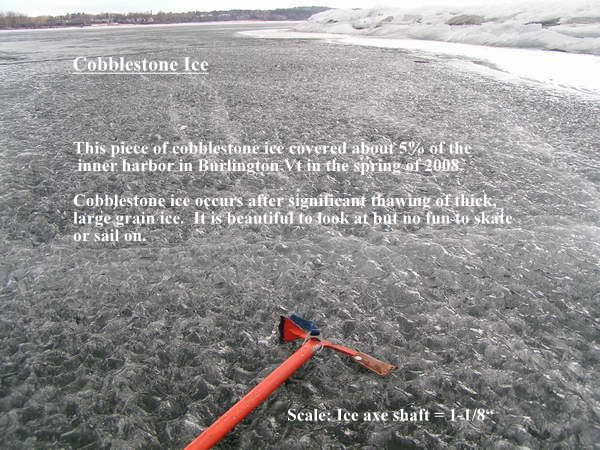Cobblestone Ice
Cobblestone ice is a relatively uncommon form of very rough, spring, large grain ice.

When a thick icesheet is thawed enough to melt the grain boundaries all the way through the sheet, an unusual and very rough ice surface can result. The ice melts faster at and near the grain boundaries causing valleys to form on the boundaries. The depth of the valleys is limited by how high the ice floats. The horizontal dimension of the roughness is proportional to the grain size. This results in a very rough, polished surface that is more than a little unpleasant to skate or sail over. Small grain ice does the same thing but the scale is smaller and the ice is weak enough that it is no where near as rough. Johan Porsbey (Sweden) has observed that cobblestone ice occurs most often with a grain size around 4" and less so with bigger or smaller average grain sizes.
In most cases cobblestone ice is relatively limited in extent (ten to a few hundred feet). Occasionally it covers most of a lake or bay. If there is enough cold weather to refreeze the grain boundary drain holes followed by enough rain or melted snow to fill in the valleys, smooth ice can come back.
Wind scalloped ice is a similar condition that is associated with sustained high winds and warm temperatures. Wind scalloping will form on any ice type. Scalloped ice creates round bottomed depressions. Cobblestone ice tends to have 'v' shaped depressions. It is likely that both conditions will appear on the same ice, one of them overprinting the other.
Note: the term 'cobblestone ice' is also used to describe the rough surface that develops on roads in significant freezing rain events or packable snowfalls. After an ice layer forms, heavy trucks partially break up the ice layer creating surface similar to a cobblestone road. Click here for an report on cobblestone ice in North Texas. If the resources are available, it is common practice to put ice removal brine or deicing salt on road surfaces just pior to the start of a storm. That significantly reduces the adhesion of a packed snow or ice layer to the cold pavement. Click here for more in snow and ice removal from highways.

